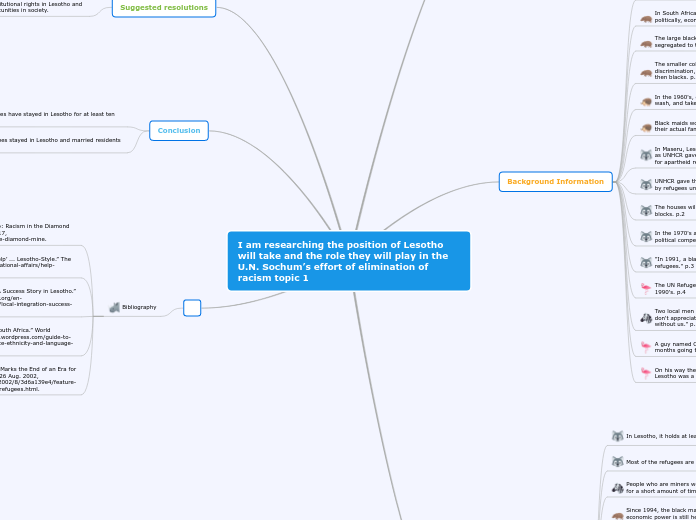I am researching the position of Lesotho will take and the role they will play in the U.N. Sochum’s effort of elimination of racism topic 1
Introduction
Lesotho is a small mountain kingdom in South Africa. p.1
Lesotho is one of the poorest countries. p.1
In South Africa, there are any different races, culture identities, languages, and ethnic bonds. p.1
In apartheid South Africa, there were four official racial categories: black, colored, white, and Asian-Indian. p.1
Race and ethnicity were explosive ideas after 1948, when apartheid was established. p.1
Refugees are not a problem in Lesotho p.1
Background Information
South Africa has had a multi-racial democracy since 1994, but the major cities remain largely racially segregated. p.2
In South Africa, the white minority was the ruling class-politically, economically, and socially. p.5
The large black majority were denied any rights and were segregated to the Shanty towns of major cities. p.5
The smaller colored and Indian groups also faced discrimination, but they had slightly higher social standing then blacks. p.5
In the 1960's, colored people would have to cook, clean, wash, and take care of the needs from white families. p.2
Black maids would take care of the white children more than their actual family. p.2
In Maseru, Lesotho, the UN refugee agency group also known as UNHCR gave the government buildings that were once used for apartheid refugees. p.2
UNHCR gave the government 48 brick houses that were used by refugees until the early 1990's. p.2
The houses will be used for the government to be for office blocks. p.2
In the 1970's and the 1980's, Maseru became a safe place for political competitor. p.2
"In 1991, a blanket amnesty was granted to all exiles and refugees." p.3
The UN Refugee Agency was taken out in Lesotho in the 1990's. p.4
Two local men at the end of the bar were talking saying "They don't appreciate anything. This country would fall apart without us." p.2
A guy named Congolese Mvibudulu Menakuntima spent two months going the Lesotho. p.3
On his way there, he talked to asylum seekers. They told him Lesotho was a good place to go. p.3
Country's current position
In Lesotho, it holds at least sixty refugees. p.3
Most of the refugees are nurses, teachers, or doctors. p.3
People who are miners work for a long time then only go home for a short amount of time. p.3
Since 1994, the black majority holds political power, but economic power is still held by whites. p.5
When studying different social indicators (2011), we see that the black majority is poorer, lower education levels, lives in poorer housing, and has fewer household goods. p.7
Blacks have high unemployment (41%). p.7
Blacks have low employment (38%). p.7
Most blacks have the lowest income, whereas most whites have the highest. p.7
Coloreds and Asians have income that falls in the middle. p.7
A woman working at the mines said "We work 14 days and then go home for a week. I don't want to be away from my family, but I must have a job." p.3
The Basotho workers have to take a lie-detector test more than the white workers. p.3
The workers could also be fired right at that moment if the didn't answer the question correctly. p.3
Currently Lesotho has no assistance programme. p.4
A woman named Me Anna said that Mosotho people treat them like slaves and sometimes they don't even pay them. p.5
Me Anna said "The white people are good to us, helping us all the time, teaching our children, sending us clothes. That's why we always ask: Why don't the basotho treat their own people better." P. 5
The Minister of Home Affairs made a request for the people to keep their future to themselves and to resolve any conflict calmly. p.3
Suggested resolutions
We can strive to get equal constitutional rights in Lesotho and everywhere else by equal opportunities in society.
Conclusion
Many of the refugees have stayed in Lesotho for at least ten years. p.4
Some of the refugees stayed in Lesotho and married residents there. p.3
Bibliography
McGrath, Will. “Letter From Lesotho: Racism in the Diamond Mine.” Pacific Standard, 11 Jan. 2017, psmag.com/magazine/racism-in-the-diamond-mine.
Jordan, Michael J., and By. “‘The Help’ ... Lesotho-Style.” The Mantle, www.themantle.com/international-affairs/help-lesotho-style.
Swai, Fidellis. “Local Integration - A Success Story in Lesotho.” UNHCR, 18 Sept. 2002, www.unhcr.org/en-us/news/latest/2002/9/3d8849614/local-integration-success-story-lesotho.html.
“Race, Ethnicity and Language in South Africa.” World Elections, 18 Jan. 2014, welections.wordpress.com/guide-to-the-2014-south-african-election/race-ethnicity-and-language-in-south-africa/.
Marie, Delphine. “Feature: Lesotho Marks the End of an Era for Apartheid's Refugees.” UNHCR, 26 Aug. 2002, www.unhcr.org/en-us/news/latest/2002/8/3d6a139e4/feature-lesotho-marks-end-era-apartheids-refugees.html.
